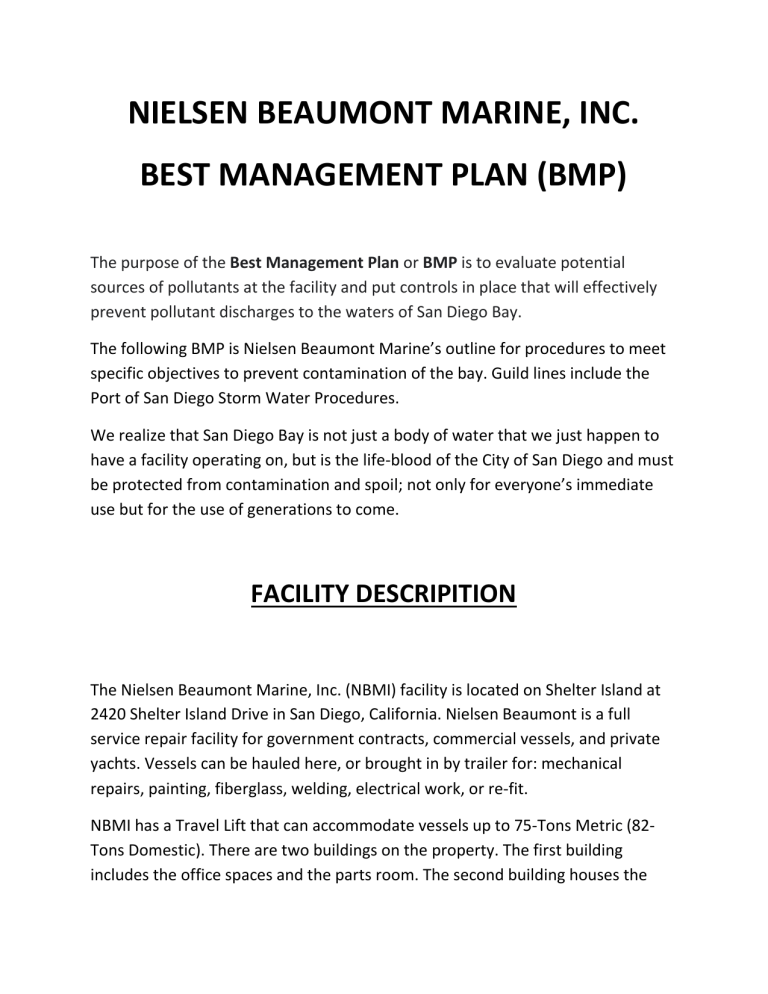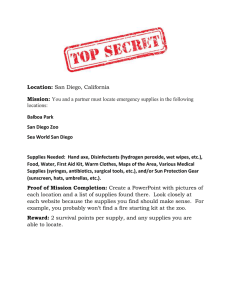
NIELSEN BEAUMONT MARINE, INC. BEST MANAGEMENT PLAN (BMP) The purpose of the Best Management Plan or BMP is to evaluate potential sources of pollutants at the facility and put controls in place that will effectively prevent pollutant discharges to the waters of San Diego Bay. The following BMP is Nielsen Beaumont Marine’s outline for procedures to meet specific objectives to prevent contamination of the bay. Guild lines include the Port of San Diego Storm Water Procedures. We realize that San Diego Bay is not just a body of water that we just happen to have a facility operating on, but is the life-blood of the City of San Diego and must be protected from contamination and spoil; not only for everyone’s immediate use but for the use of generations to come. FACILITY DESCRIPITION The Nielsen Beaumont Marine, Inc. (NBMI) facility is located on Shelter Island at 2420 Shelter Island Drive in San Diego, California. Nielsen Beaumont is a full service repair facility for government contracts, commercial vessels, and private yachts. Vessels can be hauled here, or brought in by trailer for: mechanical repairs, painting, fiberglass, welding, electrical work, or re-fit. NBMI has a Travel Lift that can accommodate vessels up to 75-Tons Metric (82Tons Domestic). There are two buildings on the property. The first building includes the office spaces and the parts room. The second building houses the Electrical Shop, Fabrication/Welding Shop, Mechanical Shop, Carpenter Shop, and Navy RHiB Shop. The Paint Shop is located in a separate conex container. The facility has dock space for vessels to be worked on that do not require to be hauled out. There is also a secured dock area to store seized vessels that are part of a Treasury Department Contract. The heart of the NBMI facility and its effort to keep contaminates out of San Diego Bay is in the design of the facility itself. This facility is a “zero discharge” facility and is one of a kind. Zero discharge means that water is collected in the yard and does not reach San Diego Bay. “Water” comes in two forms here at the yard: rain water and water used in the projects for the yard (Hydro-washing, washing of vessels, running outboards for maintenance). First, the entire yard surface is made of concrete and the outer edges are raised to form “berms” that keep water inside the yard. The yard is designed to capture and hold more rain water equal to a 100-year rain event in San Diego. Second, is that the yard is designed so that there are three distinct areas that are sloped in a bowl fashion to contain water. This water is treated in 1 of 2 ways. One of the sloped containment areas is the designated spot for the hydrowashing of vessels for bottom work to be completed, such as the painting of the bottom with anti-fouling paint that prevents the growth of marine organisms. The water collected in this area goes through a bag filter system to collect the solids and then is stored in a below-ground vault. This water is then pumped into the first of two above ground storage containers where the solids are separated and fall to the bottom. This water then over-flows at the top of container into the second storage container. From here it goes into a purification system to filter and clean the water before going through a UV light source. This “clean” water is then “re-used” to hydro-wash other vessels. This water is recycled and the whole process is a closed loop system. The other two sloped containment areas go to a vault where the water is stored before being pumped into a 4-stage clarifier to remove the solids before it goes into the City of San Diego Sewer system. The design of this facility is so that water; rain water or another sources of water; are contained, treated, and cleaned of contaminates before being processed or recycled: none of this water reaches San Diego Bay that may contain contaminates. BMP POLICY and OBJECTIVES Best Management Practices are inherently pollution prevention practices. Traditionally, BMPs have focused on good housekeeping measures and good management techniques intending to avoid contact between pollutants and water media as a result of leaks, spills, and improper waste disposal. NBMI’s goal is to prevent or eliminate toxic pollutants and hazardous substances from entering the adjacent waters of San Diego Bay. We do recognize that accidents can and do happen, but we are dedicated to do all that is possible to prevent a potential spill or pollutants from entering the bay. If not prevent then control to minimize the impact on the bay. RISK IDENTIFICATION AND ASSESSMENT 1) This yard is a zero discharge facility. Wash-water and rainfall are treated or recycled so that none of the water or contaminates reaches San Diego Bay 2) On the water risk: Fueling of vessels at the docks is not permitted. Emergency spill Kits are located on each dock for accidental dis-charges from the bilges of vessels that may contain oils for fuels. Employees are trained on emergency procedure for spills 3) Transferring of fuel in the yard: On some navy contracts, fuel is transferred to 50-gal drums to be stored in the HazMat area for disposal. The Crane and Travel Lift are re-fueled in the yard. The yard has a designated transfer pump for this. Pads are placed down for spills and care is taken to avoid an accidental spill. The process is closely monitored to prevent spills and even small spills are cleaned up immediately. 4) The HazMat area is inspected daily for issues regarding the materials stored awaiting pick-up. Pick-ups are scheduled as needed. Employees are trained on the proper procedure for handling and disposing of HazMat materials. The materials are stored on containment pallets and are covered for rain. 5) Paint/sanding Issues: Painting/sanding is done inside enclosures and special vacuum sanders are used to minimize airborne dust. The paint guns are top of the line as to minimize over spray. The area is swept and the residue is disposed of in the HazMat area. The yard is swept with a mechanical sweeper daily. 6) Containment of HazMat and used batteries. Used lead-acid batteries are stored in a designated area on containment pallets and covered. 7) The shops and other working areas are cleaned on a regular basis to cleanup possible contaminates. Before rain events, the yard is inspected and cleaned. The covers to the trash cans and the dumpsters are checked so they are closed. ENFORCEMENT OF THE Port Of San Diego’s In-the-water Hull Cleaning Permit: Routine cleaning of the hulls in the water at this facility is not permitted in an effort to reduce the releasing of contaminates; mainly copper that are in most anti-fouling paints. If cleaning is necessary, only the metals and running gear are cleaned, which does not have anti-fouling paint for protection, and contained marine growth. Procedures for Spills A spill could be diesel fuel, gasoline, hydraulic fluid, paint, thinner, or debris from sanding. Spills in the yard: Any spill, large or small, involving hazardous materials needs to be contained and then cleaned up immediately. There are oil soak pads, “pigs”, and oil booms located in the tool room. “Oil Dry” and/or cat litter is also located in the tool room and normally kept just outside the tool room during work hours. After the clean up the hazardous clean-up materials must be disposed of properly in the containment area in the yard for hazardous materials and in the appropriate barrels. Spills need to be reported to the Yard Manager or Safety Manager. Spills on the water: Any spill involving hazardous materials into the waters of San Diego Bay needs to be contained and then cleaned up immediately. Each of the 2 docks has Oil Response Lockers that contains oil pads and oil booms. The tool room also has additional booms and pads. Spills need to be reported to a Safety Manager Jay Worsham so the spill can be evaluated and reported to the Coast Guard as required. NOTE: the used of dispersants are illegal. If the spill appears to be from one of the vessels berthed at the docks, Jay Dana the Operations Manager; Kevin Whitley Yard Manager; or Jay Worsham Safety Manager needs to be alerted so the boats bilges can be checked to find the source of the leak and stopped. Best Management Practices Committee Personnel Tom Nielsen Owners Representative Jay Worsham Safety Manager Jay Dana Operations Manager Kevin Whitley Yard Manager BMP Committee Meeting: 20 February 2017 Reviewed the FED-OSHA Inspection 17 February 2017. NBMI SAFETY MEETING 31 March 2017 A mandatory monthly safety meeting was held and the following topic(s) was discussed I anticipation of the inspection by the Port of San Diego. 1) What is looked at during the inspection. 2) Employees exspectations. 3) General over-view of the Stormwater program.

